A 'mad race to the finish'
In 1961, Marshall W. Nirenberg of the National Institutes of Health and his postdoctoral associate, Heinrich Matthaei, shot to fame for “breaking the genetic code.” Their work launched the era of genomics, leading to the Human Genome Project, whole-genome sequencing and personalized medicine.
In the now-famous polyU experiment, Nirenberg and Matthaei showed that a synthetic RNA made of only uracils coded for the amino acid phenylalanine (1). But the polyU experiment was just the beginning. Scientists still had to work out how many bases were in a codon and which codon corresponded to which amino acid.
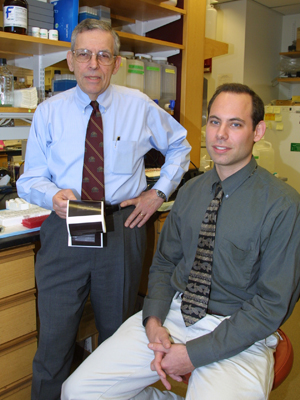 Philip Leder in 2002 in his laboratory at Harvard Medical School with then-graduate student Benjamin Leader. Photo courtesy of Steve Gilbert
Philip Leder in 2002 in his laboratory at Harvard Medical School with then-graduate student Benjamin Leader. Photo courtesy of Steve Gilbert
In 1962, a year after the polyU experiment, Philip Leder joined Nirenberg’s laboratory as a research associate. He used artificial RNA sequences of three nucleotides in cell-free systems as an assay for the genetic code. The fragments were long enough to let ribosomes bind with the complementary aminoacyl-tRNA molecule and still be detectable. Leder and other members of Nirenberg’s laboratory radioactively labeled one amino acid at a time in a mixture of the 20 amino acids and put the mixture through a filter. The filter let unbound aminoacyl-tRNAs pass through but caught the ribosomes. The sample in the filter was then tested for radioactivity. If radioactivity was present, then the labeled aminoacyl-tRNA matched the codon in the oligonucleotide; the sequence of bases in the codon was the code for amino acid carried by the tRNA.
With this assay, Nirenberg’s group deciphered most of the codons by 1966. In 1968, Nirenberg shared the Nobel Prize in physiology or medicine with Robert W. Holley and Har Gobind Khorana for deciphering the genetic code.
Subsequently, Leder’s career led to understanding the genetic underpinnings of the immune system and cancer. His work garnered him, among other things, the Lasker Award and the National Medal of Science. One of his seminal contributions was the introduction of oncogenes into laboratory mice to make transgenic animals. Leder recently retired from Harvard Medical School.
Leder spoke with ASBMB Today to reflect on the experiments he embarked on 50 years ago. Below are edited excerpts from the interview.
What prompted you to join Nirenberg’s laboratory in 1962?
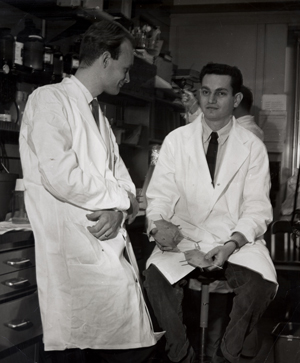 Marshall Nirenberg (seated) with Heinrich Matthaei. The duo performed the first experiment that started the race to crack the genetic code. Photo courtesy of National Institutes of Health/Department of Health and Human Services.
Marshall Nirenberg (seated) with Heinrich Matthaei. The duo performed the first experiment that started the race to crack the genetic code. Photo courtesy of National Institutes of Health/Department of Health and Human Services.
It’s an interesting story and says something about the history of the time. I graduated from medical school and was training to do primary care in internal medicine. In those days, anybody who was a physician got drafted. It was just about that simple. The Berlin Wall had gone up. People in the political and military circles were anticipating difficulties [during the Cold War], so that resulted in drafting all eligible physicians. I got drafted, so I applied for a position in the Public Health Service, which supplied physicians and scientists to the National Institutes of Health in Bethesda.
A friend at NIH told me that I ought to meet Marshall Nirenberg because he was doing interesting experiments with the genetic code. Frankly, I didn’t know anything about the genetic code. But I went to see Marshall, and he explained to me what he was doing and its importance. It was the most fascinating thing I’d ever heard. Marshall was quite a young guy at the time – I think in his late 20s or early 30s – and conveyed a lot of enthusiasm and excitement.
What was going on at the time with the genetic code?
There was a mad race to the finish. We were competing with a large biochemical laboratory in New York University run by Nobel laureate Severo Ochoa. It was quite a horse race. The polyU experiment which Marshall and Matthaei did was essential to the beginning of the process. The race was a lot of fun to watch up close.
How did the polyU experiment set the stage for your experiments?
By the time I arrived in the laboratory, the polyU experiment had been done. It had elucidated the fact that some sequence of uridylic acid resides constituted phenylalanine. But it didn’t tell us what, for example, UCU coded for or what were the other codons. It didn’t even tell us how many bases were actually needed in a codon. There was a lot of speculation. But that was the problem I worked on.
What did the assay that you and your colleagues in Nirenberg’s laboratory designed reveal?
By purification and enzymatic degradation techniques, we were able to develop very short oligoribonucleotide sequences and show that the code was triplet code. Two Us didn’t induce the binding of phenylalanine-tRNA to ribosomes. But three nucleotides set up in a row did, in fact, induce the binding of phenylalanine. So from that we knew, for example, that the code word for phenylalanine was a series of 3 Us.
I had noticed in a scientific magazine that a company in Germany was selling diribonucleotides. I bought all 16 diribonucleotides, which all had known sequences. I then systematically added a base to each of them to make triplets. [Ochoa’s] large group in New York was very good and had developed an enzyme called polynucleotide phosphorylase. I used that enzyme to synthesize the oligoribonucleotides. I developed an array of what ultimately became 64 triplets. Most of them encoded an amino acid except, of course, the termination codons.
What was the atmosphere like?
I couldn’t sleep for days at a time because of the excitement! I must admit it was very competitive; there’s no question about that. I would go to bed thinking about the next day’s experiments and then jump out of bed in the morning and rush to the laboratory. I stayed late at night. It was a lot of work but the intellectual excitement was enormous.
Were there any other projects going on in the Nirenberg laboratory?
Oh no. This was the only focus of the laboratory by that time. The nice thing about it was that it had a solid end-point – the code elucidated. Biology is so complex that it’s unusual to have questions with simple and clean answers. But this is one example. The genetic code is the genetic code.
What lessons can young scientists draw from these experiments?
First of all, I paraphrase Isaac Newton when I say we all stand on the shoulders of those who have gone before us in the acquisition of knowledge. The other [lesson] is the genetic code allows us to see the beautiful construct that evolution has created. The genetic code is exquisitely important and, at the same time, aesthetically pleasing.
Even though the code has been known for a long time, there’s still a lot that can be done with it that is important. Understanding diseases, all of which have genetic components, is one. It’s going to be an important source of investigation for at least the next 20 years. There’s nothing that can really beat this.
You can see copies of Leder’s NIH notebooks from 1963 to 1965 here.
The NIH’s collection of Marshall Nirenberg’s papers and biography are housed here.
References
1. Nirenberg, M.W. and Matthaei, J.H. (1961) The dependence of cell-free protein synthesis in E. coli upon naturally occurring or synthetic polyribonucleotides. Proc. Natl. Acad. Sci. 47, 1588 –1602.
Enjoy reading ASBMB Today?
Become a member to receive the print edition four times a year and the digital edition monthly.
Learn moreGet the latest from ASBMB Today
Enter your email address, and we’ll send you a weekly email with recent articles, interviews and more.
Latest in Science
Science highlights or most popular articles
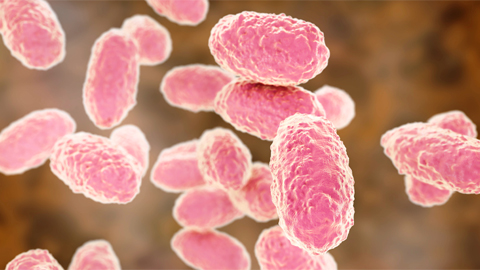
Targeting toxins to treat whooping cough
Scientists find that liver protein inhibits of pertussis toxin, offering a potential new treatment for bacterial respiratory disease. Read more about this recent study from the Journal of Biological Chemistry.
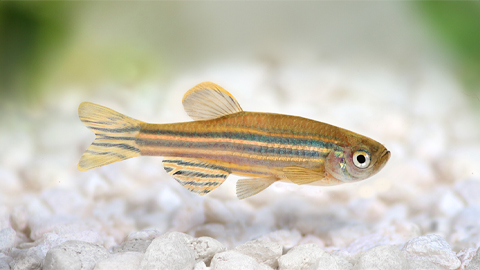
Elusive zebrafish enzyme in lipid secretion
Scientists discover that triacylglycerol synthesis enzyme drives lipoproteins secretion rather than lipid droplet storage. Read more about this recent study from the Journal of Biological Chemistry.

Scientists identify pan-cancer biomarkers
Researchers analyze protein and RNA data across 13 cancer types to find similarities that could improve cancer staging, prognosis and treatment strategies. Read about this recent article published in Molecular & Cellular Proteomics.
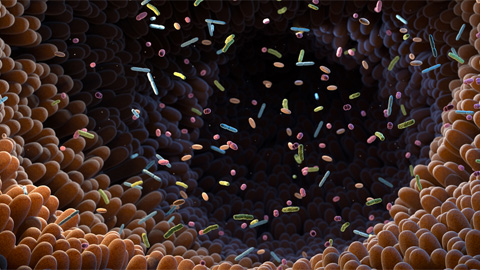
New mass spectrometry tool accurately identifies bacteria
Scientists develop a software tool to categorize microbe species and antibiotic resistance markers to aid clinical and environmental research. Read about this recent article published in Molecular & Cellular Proteomics.
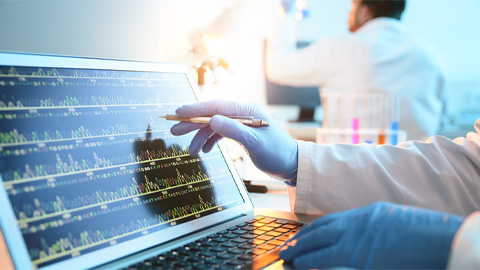
New tool matches microbial and metabolic metaproteomic data
Scientists develop a bioinformatics program that maps omics data to metabolic pathways. Read about this recent article published in Molecular & Cellular Proteomics
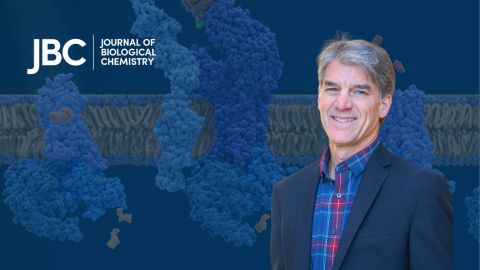
Meet Paul Shapiro
Learn how the JBC associate editor went from milking cows on a dairy farm to analyzing kinases in the lab.

